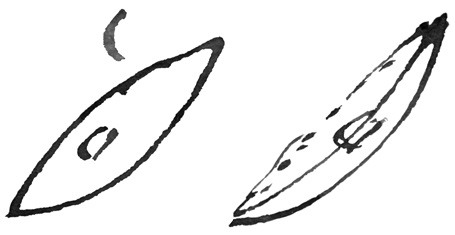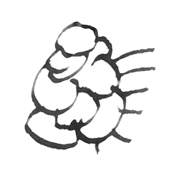From Joseph Fayrer 6 January 1875
16 Granville Place,
6 Jany 1875
Dear Mr. Darwin
I have the pleasure of enclosing the rough notes of some experiments recently made by Dr Brunton & myself on the influence of snake poison (cobra) on ciliary action, and on the Valisneria1 The results are not very definite, but they may interest you. Pray do what you think best with them.2
I hope you are well and have not been inconvenienced by the very inclement weather we have lately had.3
We have just sent in our third and concluding paper on the physiological action of Snake poison to the Royal Society So you will, I hope, soon see it in the proceedings.4
Believe me | Your’s very truly | J. Fayrer
C. Darwin Esqr F.R.S
[Enclosure]
The following experiments were made at the suggestion of Mr C Darwin with the object of testing the influence of snake poison on ciliary action, especially in reference to its comparative action on vegetable protoplasm—as will be seen by his remarks.
June 29th. 1874
Influence of Cobra poison Ciliary action.
Expert. 1.
Ciliated epithelium from the frog’s mouth was treated with the standard watery solution of Cobra poison & examined under the microscope—
At 1·35 when examined the action of the ciliæ was vigorous
at 1–45 It was much diminished
at 1–55 It had entirely ceased
Expert 2d.
Ciliated epithelium placed under microscope—one part treated with water—the other with the poisoned solution
at 2–10 ciliary motion vigorous in both perhaps more so in that subjected to the poisoned solution
2–18. Non-poisoned ciliae active
Poisoned ciliae very feeble
2–20. non-poisoned ciliae still active
Poisoned ciliae very feeble
2–24 Non poisoned ciliae active
Poisoned— ″ very languid
2–30 Non poisoned ciliae still active
2–30 Poisoned have entirely ceased to act
It is evident from this that the poison first stimulates & then destroys the activity of the ciliary action.
Expert 5— 14 Aug
Frog’s blood placed in salt solution ·75 per cent at 1.25— on warm stage—and then subjected to the action of Cobra poison.
At first the amœboid movements of white corpuscles went on vigorously—at 2–P.M they had ceased or very nearly so in all that appeared in the field
2·30 all movement had entirely ceased.
The red corpuscles seemed more flattened, the nuclei more visible and the edges better defined assuming a pointed & more oval
 form, than usual.
form, than usual.
Aug 25— 1874
Newts blood examined. under 1/8th object glass on hot stage white corpuscles moving slowly. Cob poison applied but no perceptible change observed
June 29th. 1874—
Action of Cobra poison on muscle
Expert 1.
A standard solution of cobra poison: ·03 gramme to 4·6 cubic centimetres of water was prepared.—
PM 1·25 The gastrocnemius of a frog was separated and immersed in this solution in a watch glass— it immediately contracted considerably
1·30 The muscle contracts with current at 11
1·45 The muscle has lost its irritability does not respond to the strongest current—
Expert 2d.
At the same time, 1·25 the gastrocnemius from the other leg of the same frog immersed in water. Did not immediately contract like that placed in the poisoned solution
1·30 Contracts strongly to current at 15.— more than the poisoned muscle at 11· (at same moment)
1–45. Contracts distinctly at 11– whilst the poisoned muscle has lost all irritability.
From this it is evident that the poison first stimulates the muscular fibre to contract, but rapidly afterwards destroys its irritability.
Expert 2d.
The gastrocnemii of a frog were again treated in the same way as in the previous experiment with precisely the same results
28 June.
I made several experiments with cobra poison on ciliated epithelium of frogs mouth & found that it at first accelerated, then destroyed the action of the ciliae
Novr. 1874
Expt. XXX A little cobra poison dissolved in water added to a little water containing some of the cells scraped from the mantle of Fresh Water Mussel. Among these was a large ciliated cell which before the addition of the poison had been moving slowly although the cilia were moving actively. Immediately after the addition of the poison the cell began to spin round on its own axis with extraordinary rapidity. In about 3 minutes its motions began to be languid, the ciliary motion ceased, the cell itself elongated contracted & then slowly resumed its former shape & became perfectly motionless.
E XXXI. A little water from the interior of F Water Mussel & containing two specimens of paramœcium in active motion was examined. They were rotating with great rapidity. A little cobra poison diluted with water was added. Three minutes after the addition one was discovered with both the cilia & cell body perfectly still. The cilia of the other were still but the cell body was contracted. In about half a minute more it expanded to its normal size & then remained perfectly still.
E XXXII A piece taken from the mantle of FW. Mussel was put on a slide & examined at the end of about half an hour. Active ciliary motion could be observed both in the fringe of the mantle itself & in several specimens of Volvox.5 A little dilute poison was added. At first the ciliary motion seemed increased but in about 2 minutes it became slower & in 6 had become very languid and in 10 minutes stopped altogether in the specimens of volvox but still continued in some of the cilia of the mantle.
XXXIII A little dilute cobra poison added to a piece of the mantle of FWM. The cilia began immediately to move much more quickly. This was watched for some time. Ciliary motion not affected, or at all events not arrested after more than half an hour.
Decr 10. XXXIV A piece of the gills of F.W. Mussel placed under the microscope & a little cobra poison added at 10·40PM The cilia were extremely active. At 10·55 still active.
11·5 Several ciliated amœboid masses
 are now quiet instead of rolling over & over but the cilia on their surface are still moving
are now quiet instead of rolling over & over but the cilia on their surface are still moving
11·15. The cilia on these animals have now nearly all stopped. A few are going slowly. Those on the gills are but little affected
11·55. Those on the gills are still quite active. Those on the ciliated bodies are still moving rather more actively than before. 1·30 Those on gills have become much more sharply outlined. Many are standing still though many still move briskly
E XXXVI To another specimen a strong solution of cobra poison was added at 10·50— 1·30. cilia still moving.
E XXXVII A third specimen was laid in an almost syrupy solution of dried cobra poison at 11·28. At 11·40 no effect observable 1·30. Some have stopped but numbers are still moving quite briskly. In this case the poison seemed not to have any action on the ciliary motion
Jany 6– Ex I At 3·40 some diluted cobra poison added to Vallisneria—circulation going on vigorously. About 1/10th. gram in three drops of water.
3·58 The movements are unchanged.
5P.M Movements going on as before.
Ex no. 2. Added some solution of cobra poison to another specimen of Valisneria at 4pm. 4·10 no change.
4·45. Circulation goes on vigorously.
4·55. Perhaps rather less brisk in their movements
CD annotations
Footnotes
Bibliography
Fayrer, Joseph. 1875. The royal tiger of Bengal, his life and death. London: J. & A. Churchill.
Insectivorous plants. By Charles Darwin. London: John Murray. 1875.
Summary
Encloses results of experiments on influence of snake poison on ciliary action and vegetable protoplasm.
Letter details
- Letter no.
- DCP-LETT-9806
- From
- Joseph Fayrer, 1st baronet
- To
- Charles Robert Darwin
- Sent from
- London, Granville Place, 16
- Source of text
- DAR 58.2: 71, 73–82, DAR 164: 112
- Physical description
- ALS 4pp, encl Amem 13pp †
Please cite as
Darwin Correspondence Project, “Letter no. 9806,” accessed on 19 April 2024, https://www.darwinproject.ac.uk/letter/?docId=letters/DCP-LETT-9806.xml
Also published in The Correspondence of Charles Darwin, vol. 23


